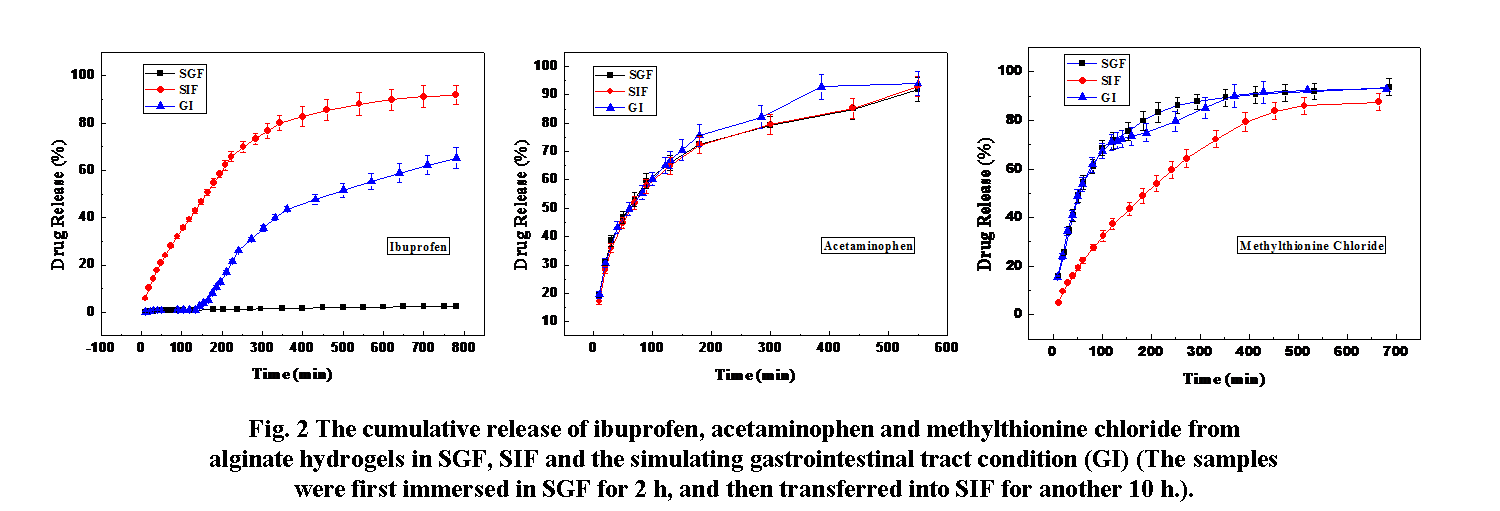Introduction: The present study shows a continuous and economically advantageous manufacture, so called solution extrusion, for the preparation of alginate hydrogels with pH-responsive property. D-glucono-δ-lactone (GDL) and CaCO3 were used as the gelation agents[1],[2], and a uniform structure was obtained after solution extrusion at room temperature (25°C), with significant drug release behavior and mechanical strength.
Materials and Methods: Materials: Sodium alginate (SA, the viscosity of 2% w/v solution at 25°C is 336 cps) was obtained from Huanghai Biological Pharmaceutical Co. (China). D-glucono-δ-lactone was purchased from Alfa-asia Co. (USA).
Preparation of alginate hydrogels: Certain amounts of sodium alginate, CaCO3, GDL, drugs and deionized water were premixed and degassed in a vacuum mixer for 10 min. The alginate solution was extruded through a single-screw extruder (d=20 mm, L/d=25) at 25°C with a screw speed of 20 rpm, and shaped by a rectangular die (20×2 mm). Then the extrudates went through a CaCl2 solution bath (3%, w/w) for the rapid solidification. Finally, the solidified extrudates were sealed at 25°C for the subsequent slow gelation, which was due to the in situ release of Ca2+ from CaCO3-GDL system.
Results and Discussion: The gelation behavior of the alginate hydrogels was investigated through a rotational rheometer. It was shown that the subsequent slow gelation of alginate was completed 20 hours after the solution extrusion. And a uniform structure of alginate hydrogel was obtained (concluded from the dispersion of the Ca element and the swell behavior of the hydrogel).
Alginate hydrogels showed a significant pH-responsive behavior: they shrunk in simulated gastric fluid (SGF, pH=1.2) and expanded in simulated intestinal fluid (SIF, pH=7.4). Considering the pKa value of alginate (3.2), the carboxylic acid groups of alginate were existed in the form of -COOH in SGF and -COO- in SIF (Fig. 1a). The shrunk of alginate in SGF was due to the hydrogen bonding between -COOH and -OH, and the expanding of alginate was due to the electrostatic repulsion of -COO- groups (Fig. 1b).

Three drugs with different solubility and pKa were employed to evaluate the in-vitro drug release behavior of the hydrogel (Fig. 2). Alginate hydrogel protected the insoluble drugs from the destruction of gastric acid, and realized the controlled release in intestine. The electrostatic attraction and repulsion between the hydrogels and charged drugs could retard or accelerate the release rate of the drugs.

Conclusion: The solution extrusion of alginate with uniform structure was achieved at room temperature, and alginate hydrogels with significant pH-responsive property was obtained. The alginate hydrogels were suitable for the oral administration of different drugs, and the solution extrusion was demonstrated to be appreciated for the pharmaceutical applications.
The authors gratefully acknowledge the support from the National Natural Science Foundation of China (21174091 and 51303111), the Funds for Doctoral Disciplines of The Ministry of Education of China (20130181120122) and the Applied Basic Research Foundation of Sichuan Province (2014JY0131).
References:
[1] Kuo C, Ma P. Ionically crosslinked alginate hydrogels as scaffolds for tissue engineering: Part 1. Structure, gelation rate and mechanical properties[J]. Biomaterials, 2001, 22(6):511–521.
[2] Wang, C., Liu, H., Gao, Q., Liu, X., & Tong, Z. (2008). Alginate–calcium carbonate porous microparticle hybrid hydrogels with versatile drug loading capabilities and variable mechanical strengths. Carbohydrate Polymers, 71(3), 476-480.